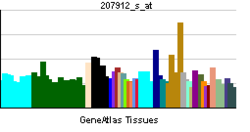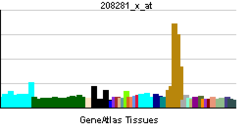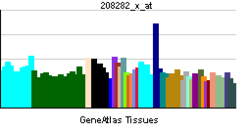- DAZ1
-
Deleted in azoospermia 1 Identifiers Symbols DAZ1; DAZ; FLJ17175; SPGY External IDs OMIM: 400003 HomoloGene: 88435 GeneCards: DAZ1 Gene Gene Ontology Molecular function • nucleotide binding
• RNA binding
• protein binding
• translation activator activityCellular component • nucleus
• cytoplasmBiological process • multicellular organismal development
• spermatogenesis
• cell differentiation
• positive regulation of translational initiationRNA expression pattern 


More reference expression data Orthologs Species Human Mouse Entrez 1617 n/a Ensembl ENSG00000188120 n/a UniProt n/a n/a RefSeq (mRNA) NM_004081 n/a RefSeq (protein) NP_004072 n/a Location (UCSC) Chr Y:
25.28 – 25.35 Mbn/a PubMed search [1] n/a Deleted in azoospermia 1, also known as DAZ1, is a protein which in humans is encoded by the DAZ1 gene.[1][2]
Contents
Function
This gene is a member of the DAZ gene family and is a candidate for the human Y-chromosomal azoospermia factor (AZF). Its expression is restricted to pre-meiotic germ cells, particularly in spermatogonia. It encodes an RNA-binding protein that is important for spermatogenesis. Four copies of this gene are found on chromosome Y within palindromic duplications; one pair of genes is part of the P2 palindrome and the second pair is part of the P1 palindrome. Each gene contains a 2.4 kb repeat including a 72-bp exon, called the DAZ repeat; the number of DAZ repeats is variable and there are several variations in the sequence of the DAZ repeat. Each copy of the gene also contains a 10.8 kb region that may be amplified; this region includes five exons that encode an RNA recognition motif (RRM) domain. This gene contains three copies of the 10.8 kb repeat. However, no transcripts containing three copies of the RRM domain have been described; thus the RefSeq for this gene contains only two RRM domains.[1]
Interactions
DAZ1 has been shown to interact with DAZAP2,[3] DAZL[4][3] and DAZ associated protein 1.[3]
References
- ^ a b "Entrez Gene: DAZ1 deleted in azoospermia 1". http://www.ncbi.nlm.nih.gov/sites/entrez?Db=gene&Cmd=ShowDetailView&TermToSearch=1617.
- ^ Reijo R, Lee TY, Salo P, Alagappan R, Brown LG, Rosenberg M, Rozen S, Jaffe T, Straus D, Hovatta O (August 1995). "Diverse spermatogenic defects in humans caused by Y chromosome deletions encompassing a novel RNA-binding protein gene". Nat. Genet. 10 (4): 383–93. doi:10.1038/ng0895-383. PMID 7670487.
- ^ a b c Tsui, S; Dai T, Roettger S, Schempp W, Salido E C, Yen P H (May. 2000). "Identification of two novel proteins that interact with germ-cell-specific RNA-binding proteins DAZ and DAZL1". Genomics (UNITED STATES) 65 (3): 266–73. doi:10.1006/geno.2000.6169. ISSN 0888-7543. PMID 10857750.
- ^ Ruggiu, M; Cooke H J (Jul. 2000). "In vivo and in vitro analysis of homodimerisation activity of the mouse Dazl1 protein". Gene (NETHERLANDS) 252 (1–2): 119–26. doi:10.1016/S0378-1119(00)00219-5. ISSN 0378-1119. PMID 10903443.
Further reading
- Foresta C, Ferlin A, Moro E, et al. (2002). "[Microdeletion of chromosome Y in male infertility: role of the DAZ gene]". Ann. Ital. Med. Int. 16 (2): 82–92. PMID 11688365.
- Fox MS, Reijo Pera RA (2002). "Male infertility, genetic analysis of the DAZ genes on the human Y chromosome and genetic analysis of DNA repair". Mol. Cell. Endocrinol. 184 (1–2): 41–9. doi:10.1016/S0303-7207(01)00646-3. PMID 11694340.
- Vogt PH, Fernandes S (2003). "Polymorphic DAZ gene family in polymorphic structure of AZFc locus: Artwork or functional for human spermatogenesis?". APMIS 111 (1): 115–26; discussion 126–7. doi:10.1034/j.1600-0463.2003.11101161.x. PMID 12752250.
- Reijo R, Lee TY, Salo P, et al. (1995). "Diverse spermatogenic defects in humans caused by Y chromosome deletions encompassing a novel RNA-binding protein gene". Nat. Genet. 10 (4): 383–93. doi:10.1038/ng0895-383. PMID 7670487.
- Reijo R, Seligman J, Dinulos MB, et al. (1996). "Mouse autosomal homolog of DAZ, a candidate male sterility gene in humans, is expressed in male germ cells before and after puberty". Genomics 35 (2): 346–52. doi:10.1006/geno.1996.0366. PMID 8661148.
- Cooke HJ, Lee M, Kerr S, Ruggiu M (1996). "A murine homologue of the human DAZ gene is autosomal and expressed only in male and female gonads". Hum. Mol. Genet. 5 (4): 513–6. doi:10.1093/hmg/5.4.513. PMID 8845845.
- Saxena R, Brown LG, Hawkins T, et al. (1996). "The DAZ gene cluster on the human Y chromosome arose from an autosomal gene that was transposed, repeatedly amplified and pruned". Nat. Genet. 14 (3): 292–9. doi:10.1038/ng1196-292. PMID 8896558.
- Yen PH, Chai NN, Salido EC (1997). "The human autosomal gene DAZLA: testis specificity and a candidate for male infertility". Hum. Mol. Genet. 5 (12): 2013–7. doi:10.1093/hmg/5.12.2013. PMID 8968756.
- Menke DB, Mutter GL, Page DC (1997). "Expression of DAZ, an azoospermia factor candidate, in human spermatogonia". Am. J. Hum. Genet. 60 (1): 237–41. PMC 1712565. PMID 8981970. http://www.pubmedcentral.nih.gov/articlerender.fcgi?tool=pmcentrez&artid=1712565.
- Yen PH, Chai NN, Salido EC (1997). "The human DAZ genes, a putative male infertility factor on the Y chromosome, are highly polymorphic in the DAZ repeat regions". Mamm. Genome 8 (10): 756–9. doi:10.1007/s003359900560. PMID 9321470.
- Agulnik AI, Zharkikh A, Boettger-Tong H, et al. (1998). "Evolution of the DAZ gene family suggests that Y-linked DAZ plays little, or a limited, role in spermatogenesis but underlines a recent African origin for human populations". Hum. Mol. Genet. 7 (9): 1371–7. doi:10.1093/hmg/7.9.1371. PMID 9700189.
- Tsui S, Dai T, Roettger S, et al. (2000). "Identification of two novel proteins that interact with germ-cell-specific RNA-binding proteins DAZ and DAZL1". Genomics 65 (3): 266–73. doi:10.1006/geno.2000.6169. PMID 10857750.
- Ruggiu M, Cooke HJ (2000). "In vivo and in vitro analysis of homodimerisation activity of the mouse Dazl1 protein". Gene 252 (1–2): 119–26. doi:10.1016/S0378-1119(00)00219-5. PMID 10903443.
- Saxena R, de Vries JW, Repping S, et al. (2000). "Four DAZ genes in two clusters found in the AZFc region of the human Y chromosome". Genomics 67 (3): 256–67. doi:10.1006/geno.2000.6260. PMID 10936047.
- Reijo RA, Dorfman DM, Slee R, et al. (2000). "DAZ family proteins exist throughout male germ cell development and transit from nucleus to cytoplasm at meiosis in humans and mice". Biol. Reprod. 63 (5): 1490–6. doi:10.1095/biolreprod63.5.1490. PMID 11058556.
- Moro E, Ferlin A, Yen PH, et al. (2000). "Male infertility caused by a de novo partial deletion of the DAZ cluster on the Y chromosome". J. Clin. Endocrinol. Metab. 85 (11): 4069–73. doi:10.1210/jc.85.11.4069. PMID 11095434.
- Xu EY, Moore FL, Pera RA (2001). "A gene family required for human germ cell development evolved from an ancient meiotic gene conserved in metazoans". Proc. Natl. Acad. Sci. U.S.A. 98 (13): 7414–9. doi:10.1073/pnas.131090498. PMC 34683. PMID 11390979. http://www.pubmedcentral.nih.gov/articlerender.fcgi?tool=pmcentrez&artid=34683.
- Friel A, Houghton JA, Glennon M, et al. (2002). "A preliminary report on the implication of RT-PCR detection of DAZ, RBMY1, USP9Y and Protamine-2 mRNA in testicular biopsy samples from azoospermic men". Int. J. Androl. 25 (1): 59–64. doi:10.1046/j.1365-2605.2002.00326.x. PMID 11869379.

This protein-related article is a stub. You can help Wikipedia by expanding it.
